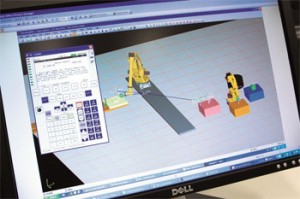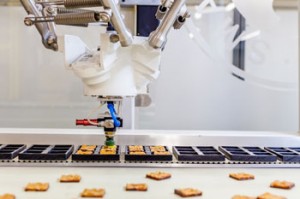Food industry robot uptake is accelerating
 Although way behind the rest of the EU and US markets in terms of sales, the UK food industry has taken a sudden interest in food industry robot technology over the last 12 months, writes John Rainer, regional sales manager for Fanuc UK (pictured left).
Although way behind the rest of the EU and US markets in terms of sales, the UK food industry has taken a sudden interest in food industry robot technology over the last 12 months, writes John Rainer, regional sales manager for Fanuc UK (pictured left).
We predict that food industry robot sales to this sector will amount to 600 units over the next 5 years – a 27% increase on the combined figures for the last five years. Testament to this, many of our system integrator partners are experiencing a dramatic rise in enquiries for food industry robot handling technology. Take Pacepacker Services for example: over the last six months they have quoted 150+ food industry robot orientated projects – a 35% increase on 2013 figures.
This growth is echoed by the British Automation and Robotics Association (BARA) which on publishing their figures for robotic sales in 2013, revealed a 60% increase in food industry robot sector adoption compared to 2000. Further to this, the International Federation of Robotics forecasts that two million jobs will be created in the next eight years because of the application of food industry robot technology. What’s more, this study predicts that between 60,000 and 80,000 new activity jobs will be created in the food industry alone from 2012 to 2016 due to food industry robot adoption.
Food manufacturers face a number of challenges in their production operations, and food industry robot technology can help to address these challenges. In a manual process, manufacturers must deal with ergonomic issues, labour availability and the uncertainty of increasing costs associated with legislation. In an automated process, accommodating rapid-fire product and pack changes driven by sustainability initiatives and shelf impact, as well understanding and improving key performance measures such as Overall Equipment Effectiveness (OEE), are key. And in any process, food safety is an overriding concern on the minds of processors, as the consequences of foodborne illness and/or massive product recalls have affected a wide range of food categories.
So what’s recently changed in the world of robotics making it easier for food producers to adopt food industry robot automation?
Strengthening the business case
Although the cost of a food industry robot has reduced (for example the cost of FANUC’s latest palletiser is 7% lower compared to its predecessor, yet has a 12% increase in payload capacity), this alone hasn’t improved their viability in the food industry. We’ve strengthened the business case for food industry robot adoption by providing the necessary functionality that a food producer needs. Only in the last 12-18 months have we made available IP69K certified food industry robot products to meet the toughest of hygiene standards.
Although rare, there are on average about 180 cases of listeriosis reported to the UK Food Standards Agency each year. A presence, or suggestion of that Listeria was initiated at a facility, can seriously tarnish a food producer’s brand image.
In addition to the cost of taking corrective action and recalling a range, production may be suspended, impacting earnings and profits long-term. Over the course of the last 10 years, food manufacturers have faced greater pressure to adhere to increasingly stringent levels of compliance. Whether responding to individual Retailer Codes of Practice (COP) or the latest requirements set out by the British Retail Consortium, manufacturers must demonstrate tight product control and complete line integrity. Manufacturers looking to improve hygiene, by removing the uncertainty that the human element brings to the equation, have been driving the need for food-grade equipment.
Pictured: FANUC robots with iRVision can easily distinguish products randomly placed on a line.
Technology improvements including vision, the versatility of the robot hand or end effector and integral controllers will have a big impact on food industry robot design over the next five years and with this make them easier to integrate into food production. For food industry robot technology to be adopted widely by food producers precision, dexterity, accuracy, speed and the size of a food industry robot are the key considerations. The incredible pace at which vision technology is developing, now with a more economical price tag, enables the food industry robot to be used to distinguish differences in size, shape and colour, but also greatly improves the accuracy of sorting, picking and placing countless food objects randomly placed across numerous lines. Furthermore, vision’s code reading capabilities can play a key role in helping food companies to meet product traceability requirements.
With continuous product changes afoot, a food industry robot’s hand, or end effector, has to be highly versatile and able to handle the most delicate of products. The key is to strike the right balance between secure and gentle handling. If product is dented, bruised or scuffed, consumers will reject it. Handling technology has improved so greatly of late, that system integrators are now designing end effectors combining vacuum, gripper and clam-shell styles offering a multifunctional solution to keep abreast of production changes at minimal expense. Now a single food industry robot can complete a wide range of tasks.
 And in production scenarios where humans and food industry robot counterparts are occupying the same space on a food production line, the latest simulation tools now satisfies stakeholder concerns over worker safety.
And in production scenarios where humans and food industry robot counterparts are occupying the same space on a food production line, the latest simulation tools now satisfies stakeholder concerns over worker safety.
Pictured: All levels of planning and programming, ROBOGUIDE makes installations and any subsequent modifications much quicker to implement, saving time and money.
FANUC’s ROBOGUIDE enables customers and integrators alike to precisely visualise and pre-programme a robotic installation in a safe and convenient virtual 3D world, before putting those plans into effect. As well as being able to predict and forestall potential new-build issues, ROBOGUIDE gives users a useful tool to scope out changing requirements and better plan for project upgrades. It can pre-empt – and help prevent – costly damage to the robot and potential injuries to co-workers.
Where food industry robot technologies of late didn’t quite meet the expectations and needs of a food producer, they now do. We have seen a positive shift in UK interest over the last 12 months and predict this will continue to accelerate now that food industry robot products, often with a 12-18 month payback, are fully meeting food producers’ needs.
Visit the FANUC website for more food industry robot information.
See all stories for FANUC
















